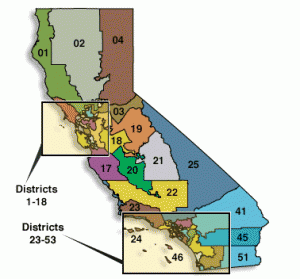 In June 2010 via Proposition 14, California radically changed the way candidates are elected to public office. Previously, candidates running for office appeared only on their party’s ballot in the primary election. Then, the winner from each political party and any independents who qualified for ballot access would move on to the general election. Then, for the general election in November, voters could choose between one Republican, one Democrat, and any number of third party and independent candidates for almost every office contest.
In June 2010 via Proposition 14, California radically changed the way candidates are elected to public office. Previously, candidates running for office appeared only on their party’s ballot in the primary election. Then, the winner from each political party and any independents who qualified for ballot access would move on to the general election. Then, for the general election in November, voters could choose between one Republican, one Democrat, and any number of third party and independent candidates for almost every office contest.
Proposition 14 changed all that. Now, under the “Top-Two Open Primary Act,” all candidates desiring to run for public office, regardless of party affiliation or preference, will appear on a single combined ballot in the primary election. Likewise, all voters, regardless of party affiliation or preference, are permitted to vote for any candidate on this combined ballot. Then, only the two candidates who receive the highest and second-highest number of votes move on to the general election. So, for the general election in November, voters can only choose between two candidates. Both candidates could be in the same party, different parties, or with any combination with independent candidates. Also, the candidates can choose whether or not to list their party affiliation on the primary and general election ballots. In other words, the top two overall vote-getters, not the top vote-getter from each political party, get on the general election ballot.
 Interestingly, the change does not apply to all offices. It only includes State-oriented offices, like U.S. Senate, U.S. House, State-wide offices, State Senate, and State House. It does not include U.S. President, county, and local offices. Nonetheless, the new election process could be a seismic change in California’s democratic process. But was it?
Interestingly, the change does not apply to all offices. It only includes State-oriented offices, like U.S. Senate, U.S. House, State-wide offices, State Senate, and State House. It does not include U.S. President, county, and local offices. Nonetheless, the new election process could be a seismic change in California’s democratic process. But was it?
Counting the number of office contests where the candidates are, and are not, of the same party in the Vote-CA.org November 6, 2012 California General Election Report provides the answer.
- For the U.S. Senate seat, there remains one incumbent Democrat and one Republican challenger.
- For the 53 U.S. House contests, 41 (77%) have one Republican and one Democrat, 6 (11%) have two Democrats, 2 (4%) have two Republicans, and 4 (7%) have an independent or no party affiliation with a Democrat (3) or Republican (1).
- For the 20 State Senate contests, 16 (80%) have one Republican and one Democrat, 2 (10%) have two Democrats, 0 have two Republicans, and 2 (10%) have an independent or no party affiliation with a Democrat.
- For the 80 State House contests, 58 (73%) have one Republican and one Democrat, 11 (14%) have two Democrats, 7 (11%) have two Republicans, and 4 (5%) have an independent or no party affiliation with a Democrat.
As we all well know, statistics can be interpreted to prove whatever one sets out to prove. So, you can look at the numbers and look at the report and then you can decide.
What I see is that about a quarter of the general election contests have candidates that would not have been on the ballot using the old system. I am not sure whether this would qualify for a ‘seismic’ change but I do believe it is a very ‘significant’ change. But, more importantly, the significance is that the process is more democratic than the old system. Simply put, round two pits the strongest contenders for the crown. Right on California!!









Leave a Reply